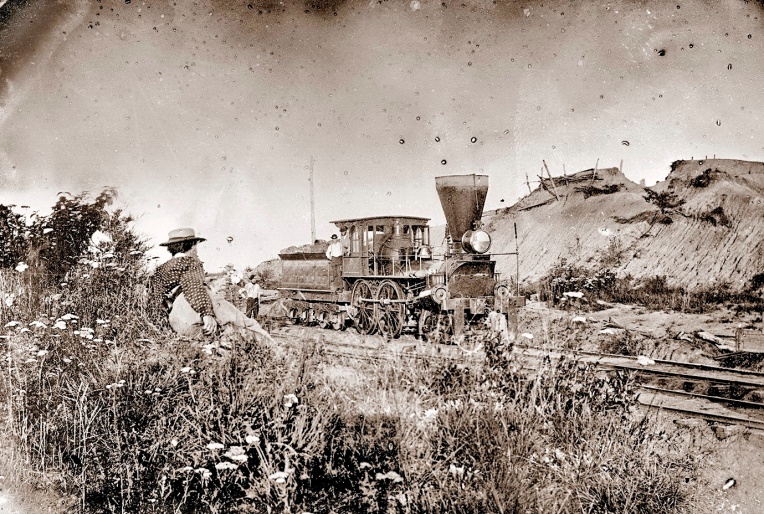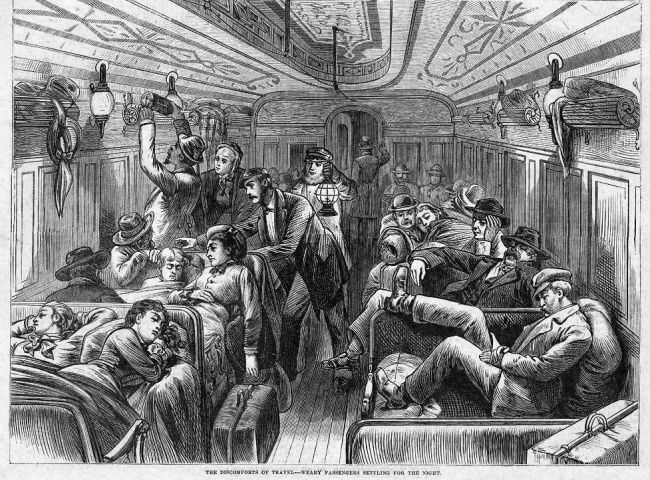LINK TO HOME PAGE/CONTENTS: HOME PAGE – CONTENTS
900 MILES OVERLAND FROM NEW YORK CITY TO WISCONSIN
contents ©2016 by Harold Pfohl

Courtesy of the David Rumsey Map Collection.
For an enlargement of this map see: David Rumsey Map Collection USA 1852
It is reasonable to assume that the 900 mile journey from the East Coast to SE Wisconsin was made by railroad which at the time was new, primitive, poorly engineered, dirty, unreliable, and uncomfortable but, even so, far superior to alternatives in terms of speed and convenience. Although railroad travel was new, it was a huge improvement in speed and access for overland transportation. Average RR speed in 1850 was usually around 20-30 mph. Both track and engine technology were rapidly improving but were at such an early stage of development that speed was very limited by our standards. However, by the standards of 1850 passengers were flying along at a great rate. The point of comparison was the speed of a fast horse.
Design and engineering were rapidly improving. The photos below of railroad engines, trackage, and stations represent conditions that were typical of the era and representative of the experience the families would have had.

The locomotive above was built in 1848. While the design and engineering progress was very rapid, rail travel from the East Coast to Wisconsin would have employed engines of similar design.

Hanover Junction Pennsylvania, 1863, railroad yards
From: Library of Congress ~ 1860
Any of the small communities that the families traveled through would have had railroad stations that resembled the photo above.

From: Library of Congress ~ 1860

From: Library of Congress ~ 1860
One could easily imagine the above scene to have been experienced traveling along the plains of Western Ohio, Indiana and Illinois

From: Library of Congress ~ 1860
A similar scene to the above Virginia port photo could easily be imagined when the emigrant train neared Chicago, bordering Lake Michigan which in the early 1850s had a population of about 45,000 and was growing at a phenomenal rate.
The train ride had to have been a very exciting adventure – speed of travel, passage through mountains, across newly settled lands, through a multitude of small villages, and through the new rail hub and Great Lakes port of Chicago (pop. 1852 – roughly 40,000), and Milwaukee (pop. 1852 – roughly 25,000). But not without considerable ordeals as described by Otto Bettman in his book “The Good Old Days – They Were Terrible:”
“…Late arrivals and departures were aggravated by the absence of the ‘check system’ for baggage, which had to be identified and retrieved by the passengers themselves. Often this led to lengthy arguments and the smashing of trunks and suitcases on the platform…train schedules of the period might as well have been calibrated by sundial or calendar…connections were more miss than hit…The old wood burning locomotives belched cinders that pattered overhead like a hailstorm, and their smoke and steam engulfed the train until at journey’s end, the traveler found himself begrimed like a man who has worked all day in a blacksmith’s. The alternative was to close the window and suffer the stenches of whiskey, tobacco, and closely packed bodies, stenches which remained imprisoned in the cars despite ceiling grills installed to ventilate them. Frequently, those who elected to suffer ashes and cinder dust over suffocation were unable to budge the windows…”

Very recent means of transportation had been voyage by water, or by horse/ox and wagon. Because of convenience and low cost of water transportation, port cities such as Milwaukee and Chicago developed rapidly, as did cities along the Mississippi River. Hence, on the map one sees settlement and RR tracks spreading out from the Milwaukee area. RR trackage is shown as black and white lines (see map below for enlargement of the Milwaukee region).
No railroad had yet been constructed from Milwaukee to the Cedarburg area (Hamilton on the 1852 map below). The Niemann family took an ox cart from Milwaukee to Cedarburg.

Courtesy of the David Rumsey Map Collection. David Rumsey Map Collection
The Niemanns and Lüders pioneered their land in Cedarburg township, Ozaukee Co., Brüss bought a small holding near Kirchayn by Jackson, Washington Co., and the Fromms settled in the “Town of Barton,” (Township) northwest of West Bend in Washington Co. Note: Washington County was divided at a later date into Washington and Ozaukee Counties.
The destinies of these four pioneering families in Wisconsin were to be intertwined in Cedarburg through their descendants.
Next – the condition of their new homeland
Just for fun: A RR & history digression – the 1860 equivalent of today’s “Air Force One” – the Presidential locomotive and car:


Are you certain these immigrants came by train fro New York? I’ve read they came up the Hudson River to the Erie Canal and entered the Great Lakes at Buffalo…especially since many early Lutherans settled in Buffalo this makes sense.
LikeLike
Chery, Thanks for the note.
I’m not certain & your point is well taken.
Regarding travel in the 1830s and 40s, the Erie Canal to Buffalo, and then via Great Lakes steamers was the most common means of travel to the upper Midwest for settlers – at least as I understand it and I have not done research on it.
With respect to the early Lutherans in Buffalo, their emigration occurred mostly in the 1830s – 1840s. There were a very large number of these “Old Lutherans” just to the east of Niagara Falls which is where my Dad’s emigrant forbears settled. That time frame would have most certainly involved the Erie Canal.
By 1852 when the principals in our story began their emigrations, I believe that railroads had reached Chicago. I’ve studied two maps showing rail networks, and it seems clear that Chicago and then Milwaukee had just then become accessible by rail.
I expect that the network of rail/ship which existed prior to that time continued for a while especially with respect to the northern regions around the Great Lakes which rail reached much later, e.g., rail to Michigan, ship to Green Bay?
Rail transport is superior in time and cost to a combination of rail and ship, and I assumed on that basis that the four families were transported by rail from NYC to Wisconsin.
The families kept no journals that we know of. What information I have comes from oral history. With that, in order to give some sense of what they must have experienced, I related what I understand was a typical experience via sailing ship across the Atlantic and then transit across the US.
Again, thanks for your note and your interest.
LikeLike
Interesting that Chicago was not that much larger than Milwaukee.
LikeLike
Interesting that Chicago was not a great deal larger than Milwaukee at that time.
LikeLike
In 1850 the population was around 30,000. It tripled by 1860. The growth was explosive. The key was the growth of railroads at the same time incredible levels of immigration, pioneering and settlement were occurring.
Interesting website – see: http://www.hcs.harvard.edu/~dreyfus/history.html
LikeLike
I am really enjoying this! I grew up by Kirchayn and recognize two of the four named families. Anxious to read more!
LikeLike
Thanks! It has been fascinating to research this over the years. I’m delighted that you’re enjoying it.
LikeLike
Great Post
LikeLike
Thanks!
LikeLiked by 1 person
welcome
LikeLike